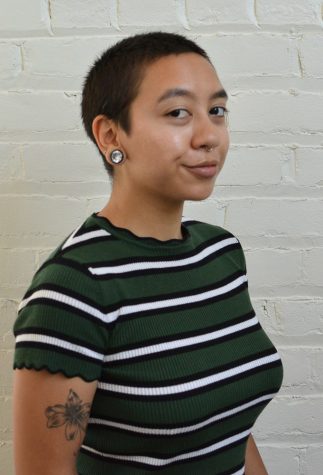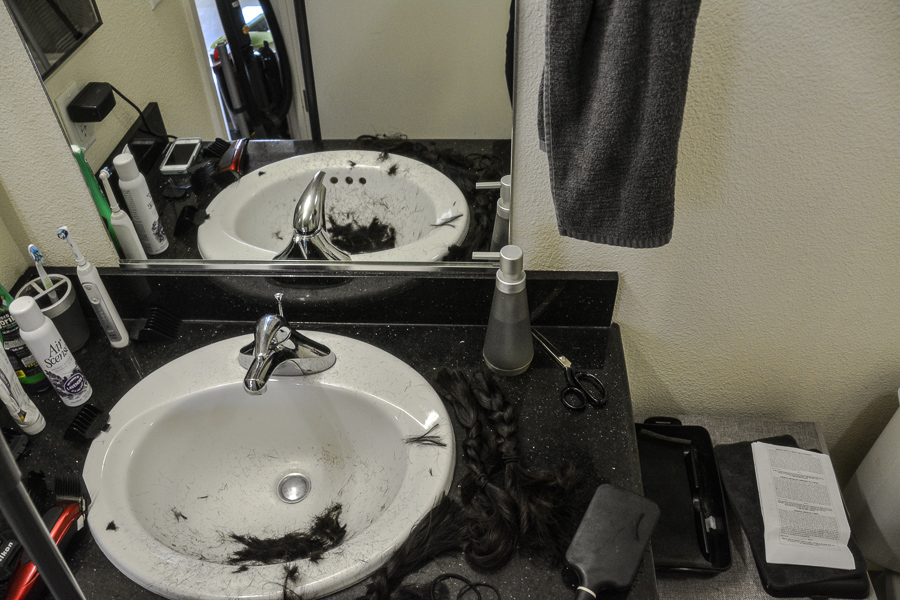
I shaved my head in quarantine, and I’m not alone
August 2, 2020
I felt the snip as I heard it. My hair, tensely pulled tight against the back of my head, relaxed as the 14-inch braid came off into my dad’s hand. Two snips later, my head was at least two pounds lighter; my shoulders dropped from my ears as I exhaled some of the weight from my mind.
After the scissors came the clippers. The loud whirring made me nervous; otherwise I was calm and proud of my decision. The brown stubble on my head boasted one-fourth of an inch and felt like hundreds of tiny dull needles when I rubbed it with my palm. I liked the feeling.
People can make drastic changes to their appearances during times of crisis. The whole world is in crisis. As the COVID-19 pandemic rages on, our political and social systems continue to defame and attack global movements for the end of oppression against Black people.

According to the American Psychological Association, data suggest that Black and Latinx Americans are disproportionately infected and killed by the coronavirus, and Native Americans have high rates of pre-existing conditions that put them at an elevated risk of COVID-19 complications.
Psychologists are struggling to provide care for patients facing intersecting issues such as access to resources, pre-existing conditions and the onslaught of trauma and violence on news and social media.
Leslie Martin is a third-year SF State student studying criminal justice. She decided during quarantine to change her hair drastically, bleaching and dyeing her locks for the first time from dark brown to amber red.
“The news of the rise of infected and death tolls due to the pandemic have definitely affected me. It has made me more compliant with the quarantine guidelines,” Martin wrote to Xpress. She went to a salon for her new cut and style, but otherwise has maintained social distancing.
“I remember feeling extremely bored and having the urge to change something drastic about me,” Martin said. “The feeling stemmed from having no control over the current situation, but I [realized] I still had control over myself. Honestly, after the dye got washed out and I was looking at the mirror, I felt like it was a mistake. It took me a day or two to finally start liking my new look.”
Martin and I both experienced that period of “Oh shit, what have I done?” after making a drastic change in our appearance. Martin’s decision to visit a professional was a smart choice; bleaching and dyeing hair is a delicate process that can end with undesired results.
“For anyone looking to change their style all I have to say is go for it. This is a great chance to experiment,” Martin said. “If something goes wrong or you’re not feeling the change then there’s lots of time to go back to your comfort zone.”
Apryl Jones is a natural hairstylist based in Oakland. She helps her clients push past their comfort zones when it comes to their hair.
Before the outbreak of the COVID-19 virus, Jones worked at HIM Barbershop, which stands for His Imperial Majesty. Jerron Robinson, who Jones said is a former member of the Black Panther Party, owned the previous shop, Martin’s. She now makes house calls in her and her clients’ homes, mostly staying in Palo Alto where she lives.
Jones is an artist. Styling hair and painting are her main mediums, and she uses blue colored pencils in pieces that honor her ancestors who crossed the Atlantic Ocean on the S.S. Clotilda in 1860, considered the last set of enslaved people from Africa.

Jones began styling hair professionally 10 years ago, but she has helped friends and family with their hair all her life. She remembers taking out a neighbor’s messy braids and neatly rebraiding them when she was seven years old.
“I touch their crowns regularly,” she said. “I believe in my clients. We speak light into each other; we’re very close.”
At HIM, Jones worked on around 35 clients per week but now takes only 10. “It’s kind of slow. It’s slow. I mean, folks, reach out to me, but I’m being safe,” she said. “You know new people, I just kind of redirect them like this ain’t the time for this.” Although she’s taking a huge drop in the number of new clients, the ones she works with now are loyal.
In the study “Is Having a Haircut Good for your Mental Health?” by Tamika Roper and John A. Barry, published in New Male Studies: An International Journal in 2016, the researchers’ purpose was to find how much customers at barbers and hairdressers reported benefits to improved wellbeing when they visit.
“Barbershops have a reputation amongst the Black community as enjoyable places to socialize and bond,” the report read. “Therefore the aim of this study was to find out whether Black men get wellbeing benefits from going to the barbershop.”
Through an online survey of 202 adults, this study is the first to find empirical evidence that Black men talk and socialize at the barber more than other people. The researchers also found that men were significantly more likely to be at the barbershop for reasons other than hair, and Black participants were significantly more likely than white participants to be there for reasons other than hair.
As a stylist, Jones creates protective hairstyles for her clients. She focuses on dreadlocks as well as braids. She said she understands how important hair can be for Black people, and she considers it a privilege to foster deep relationships with her clients.
“You gotta really know that the village that surrounds us is super strong and necessary, when you’re weak they got you,” Jones said. “We exchange books, send posts. I believe in my clients; I got some good, loving clients.”
Jones moved to Oakland from Washington D.C. in part to be closer to her mother, who works as a nurse practitioner. During quarantine, her mother asked Jones to cut off her processed hair and start anew. “I’ve been asking her to do this for two years,” Jones said. “When I asked why, she said, ‘What better time than now?’”
Jones said she thinks haircuts during this crisis can help people reconnect with themselves. “Do it outside! In the sun, by a pool, with a friend. Do whatever makes you happy,” she said.
I chose to reconnect with myself by cutting my hair in the restroom with the help of my dad. Facing a traumatic ordeal, we used this experience as an opportunity for closure and a chance to bond.

Dr. Erik Peper is a professor of holistic health at SF State. His courses aim to give students tools to manage stress and mobilize their own health, often incorporating in-class exercises and self-practice such as breathing and body movement techniques; examples of these can be found on his blog.
Peper is also publishing a book titled “TechStress—How Technology is Hijacking Our Lives, Strategies for Coping and Pragmatic Ergonomics” with SF State colleague Dr. Richard Harvey and Nancy Faass, founder of the Health Writers’ Group, publishing on August 25.
“My expertise is in biofeedback and the self,” Peper said. “We use equipment to monitor people’s reactions. We often don’t realize the way we are reacting. And we teach that this is affected by the mind, body, social and environmental factors.”
He said making changes in your appearance and environment can help. “My first suggestion when someone is depressed is to change and clean your room. Change it entirely, put up some happy posters and artwork… You’re saying, I am now a slightly different person; I want to explore a new way of being.”
The first time I cut all my hair off was right before I came out to my parents. With my new pixie cut, I felt that my outward appearance matched how I felt inside; when I told my mom I was gay, she said, “Oh honey, I knew when you cut your hair.”
“It is essentially a confirmation of self,” Peper said. “You’re affirming yourself in your body movement to the world. This is moving into action, and it’s more powerful. Most people ruminate, and it’s good to think about things, but you made a commitment, you’re courageous.”
Having a buzzed head gets a lot of attention from others. Now it’s more fashionable for young people, but it is a statement nonetheless. Members of my family shaved their heads in solidarity when my uncle began chemotherapy for Leukemia. Peper did the same when his sister was diagnosed with cancer.
For queer Brown women like me, a short, buzzed haircut can be a message, a sign of social rebellion and personal affirmation. Society expects me to have long hair to be feminine? Screw your ideals.
In the article “Lesbians and the (Re/De) Construction of the Female Body” published in 1993, author Diane Griffin Crowder addresses how queer women of that time balanced their own socialized understanding womanhood with their lived experience subverting heteronormativity.
“Lesbians are reared within the same heterosexual imperative as all women and are subjected, therefore, to the same social definitions of femininity,” Crowder’s article read.
Since the ’90s much has changed, the influence of the internet and social media shifts the perception of queer identity every day. But while this haircut was liberating for me, and other phenotypic changes can empower queer folks, many people are forced to comply with society’s standards to this day.

“Lesbian ‘passing’ has historically been a survival mechanism, allowing lesbians to avoid the harsh penalties meted out to ‘deviants,’” Crowder’s article read. “Hence, the debate in recent years over whether or not lesbians should wear long hair or makeup has been partly a debate about whether lesbians should ‘pass’ within a heterosexual society or should reject ‘heterosexual privilege.’”
I think I definitely don’t pass as straight with this haircut. I won’t for a while. And that’s a part of why I did it.
For now, I sleep better from the breeze on my head; I sit and stand a bit straighter. And this is just one small aspect I can control in a truly bonkers time. It’s a confirmation that this is a new age for me, for the world.
I figure I’ll try out a Twiggy look and keep the hair short and bangs swooped to the side. As it grows, I’ll try something more of a Spike Spiegel from “Cowboy Bebop,” a mess of dark green that seems to defy gravity. I haven’t been green in years.
And maybe after a while I’ll feel the need for another big chop.

